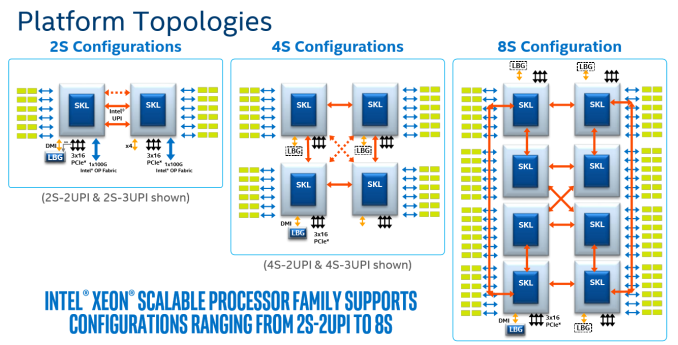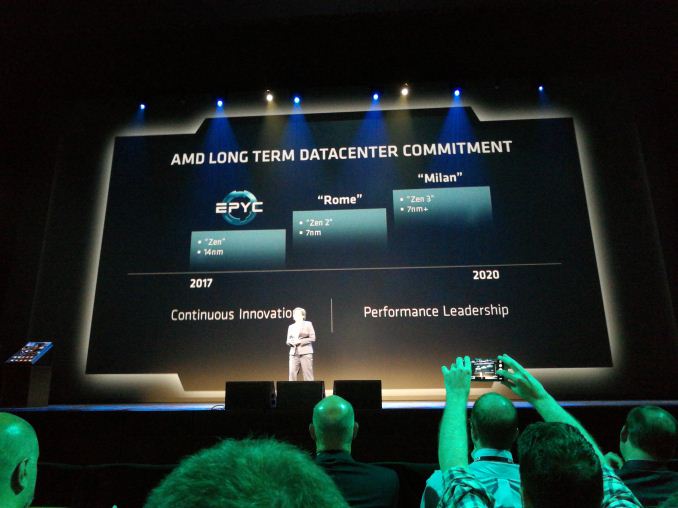Sizing Up Servers: Intel's Skylake-SP Xeon versus AMD's EPYC 7000 - The Server CPU Battle of the Decade?
by Johan De Gelas & Ian Cutress on July 11, 2017 12:15 PM EST- Posted in
- CPUs
- AMD
- Intel
- Xeon
- Enterprise
- Skylake
- Zen
- Naples
- Skylake-SP
- EPYC
Closing Thoughts
First of all, we have to emphasize that we were only able to spend about a week on the AMD server, and about two weeks on the Intel system. With the complexity of both server hardware and especially server software, that is very little time. There is still a lot to test and tune, but the general picture is clear.
We can continue to talk about Intel's excellent mesh topology and AMD strong new Zen architecture, but at the end of the day, the "how" will not matter to infrastructure professionals. Depending on your situation, performance, performance-per-watt, and/or performance-per-dollar are what matters.
The current Intel pricing draws the first line. If performance-per-dollar matters to you, AMD's EPYC pricing is very competitive for a wide range of software applications. With the exception of database software and vectorizable HPC code, AMD's EPYC 7601 ($4200) offers slightly less or slightly better performance than Intel's Xeon 8176 ($8000+). However the real competitor is probably the Xeon 8160, which has 4 (-14%) fewer cores and slightly lower turbo clocks (-100 or -200 MHz). We expect that this CPU will likely offer 15% lower performance, and yet it still costs about $500 more ($4700) than the best EPYC. Of course, everything will depend on the final server system price, but it looks like AMD's new EPYC will put some serious performance-per-dollar pressure on the Intel line.
The Intel chip is indeed able to scale up in 8 sockets systems, but frankly that market is shrinking fast, and dual socket buyers could not care less.
Meanwhile, although we have yet to test it, AMD's single socket offering looks even more attractive. We estimate that a single EPYC 7551P would indeed outperform many of the dual Silver Xeon solutions. Overall the single-socket EPYC gives you about 8 cores more at similar clockspeeds than the 2P Intel, and AMD doesn't require explicit cross socket communication - the server board gets simpler and thus cheaper. For price conscious server buyers, this is an excellent option.
However, if your software is expensive, everything changes. In that case, you care less about the heavy price tags of the Platinum Xeons. For those scenarios, Intel's Skylake-EP Xeons deliver the highest single threaded performance (courtesy of the 3.8 GHz turbo clock), high throughput without much (hardware) tuning, and server managers get the reassurance of Intel's reliable track record. And if you use expensive HPC software, you will probably get the benefits of Intel's beefy AVX 2.0 and/or AVX-512 implementations.
The second consideration is the type of buyer. It is clear that you have to tune more and work harder to get the best performance out of AMD EPYC CPUs. In many ways it is basically a "virtual octal socket" solution. For enterprises with a small infrastructure crew and server hardware on premise, spending time on hardware tuning is not an option most of the time. For the cloud vendors, the knowledge will be available and tuning for EPYC will be a one-time investment. Microsoft is already deploying AMD's EPYC in their Azure Cloud Datacenters.
Looking Towards the Future
Looking towards the future, Intel has the better topology to add more cores in future CPU generations. However AMD's newest core is a formidable opponent. Scalar floating point operations are clearly faster on the AMD core, and integer performance is – at the same clock – on par with Intel's best. The dual CCX layout and quad die setup leave quite a bit of performance on the table, so it will be interesting how much AMD has learned from this when they launch the 7 nm "Rome" successor. Their SKU line-up is still very limited.
All in all, it must be said that AMD executed very well and delivered a new server CPU that can offer competitive performance for a lower price point in some key markets. Server customers with non-scalar sparse matrix HPC and Big Data applications should especially take notice.
As for Intel, the company has delivered a very attractive and well scaling product. But some of the technological advances in Skylake-SP are overshadowed by the heavy price tags and somewhat "over the top" market segmentation.












219 Comments
View All Comments
Shankar1962 - Thursday, July 13, 2017 - link
So you think Intel won't release anything new again by then? Intel would be ready for cascadelake by then. None of the big players won't switch to AMD. Skylake alone is enough to beat epyc handsomely and cascadelake will just blow epyc. Its funny people are looking at lab results when real workloads are showing 1.5-1.7x speed improvementPixyMisa - Saturday, July 15, 2017 - link
This IS comparing AMD to Intel's newest CPUs, you idiot. Skylake loses to Epyc outright on many workloads, and is destroyed by Epyc on TCO.Shankar1962 - Sunday, July 16, 2017 - link
Mind your language assholeEither continue the debate or find another place for your shit and ur language
Real workloads don't happen in the labs you moron
Real workloads are specific to each company and Intel is ahead either way
If you have the guts come out with Q3 Q4 2017 and 2018 revenues from AMD
If you come back debating epyc won over skylake if AMD gets 5-10% share then i pity your common sense and your analysis
You are a bigger idiot because you spoiled a healthy thread where people were taking sides by presenting technical perspective
PixyMisa - Tuesday, July 25, 2017 - link
I'm sorry you're an idiot.Shankar1962 - Thursday, July 13, 2017 - link
Does not matter. We can debate this forever but Intel is just ahead and better optimized for real world workloads. Nvidia i agree is a potential threat and ahead in AI workloads which is the future but AMD is just an unnecessary hype. Since the fan boys are so excited with lab results (funny) lets look at Q3,Q4 results to see how many are ordering to test it for future deployment.martinpw - Wednesday, July 12, 2017 - link
I'm curious about the clock speed reduction with AVX-512. If code makes use of these instructions and gets a speedup, will all other code slow down due to lower overall clock speeds? In other words, how much AVX-512 do you have to use before things start clocking down? It feels like it might be a risk that AVX-512 may actually be counterproductive if not used heavily.msroadkill612 - Wednesday, July 12, 2017 - link
(sorry if a repost)Well yeah, but this is where it starts getting weird - 4-6 vega gpuS, hbm2 ram & huge raid nvme , all on the second socket of your 32 core, c/gpu compute ~Epyc server:
https://marketrealist.imgix.net/uploads/2017/07/A1...
from
http://marketrealist.com/2017/07/how-amd-plans-to-...
All these fabric linked processors, can interact independently of the system bus. Most data seems to get point to point in 2 hops, at about 40GBps bi-directional (~40 pcie3 lanes, which would need many hops), and can be combined to 160GBps - as i recall.
Suitably custom hot rodded for fabric rather than pcie3, the nvme quad arrays could reach 16MBps sequential imo on epycs/vegaS native nvme ports.
To the extent that gpuS are increasing their role in big servers, intel and nvidea simply have no answer to amd in the bulk of this market segment.
davide445 - Wednesday, July 12, 2017 - link
Finally real competition in the HPC market. Waiting for the next top500 AMD powered supercomputer.Shankar1962 - Wednesday, July 12, 2017 - link
Intel makes $60billion a year and its official that Skylake was shipping from Feb17 so i do not understand this excitement from AMD fan boys......if it is so good can we discuss the quarterly revenues between these companies? Why is AMD selling for very low prices when you claim superior performance over Intel? You can charge less but almost 40-50% cheap compared to Intel really?AMD exists because they are always inferior and can beat Intel only by selling for low prices and that too for what gaining 5-10% market which is just a matter of time before Intel releases more SKUs to grab it back
What about the software optimizations and extra BOM if someone switches to AMD?
What if AMD goes into hibernation like they did in last 5-6years?
Can you mention one innovation from AMD that changed the world?
Intel is a leader and all the technology we enjoy today happenned because of Intel technology.
Intel is a data center giant have head start have the resources money acquisitions like altera mobileeye movidus infineon nirvana etc and its just impossible that they will lose
Even if all the competent combines Intel will maintain atleast 80% share even 10years from now
Shankar1962 - Wednesday, July 12, 2017 - link
To add onNo one cares about these lab tests. Let's talk about the real world work loads.
Look at what Google AWS ATT etc has to say as they already switched to xeon sky lake
We should not really be debating if we have the clarity that we are talking about AMD getting just 5% -10% share by selling high end products they have for cheap prices....they fo not make too much money by doing that.....they have no other option as thats the only way they can dream of a 5-10% market share
For Analogy think Intel in semiconductor as Apple in selling smartphones
Intel has gross margins of ~63%
They have a solid product portfolio technologies and roadmap .....we can debate this forever but the revenues profits innovations and history between these companies can answer everything